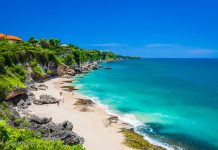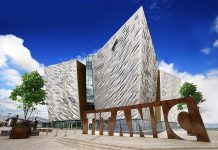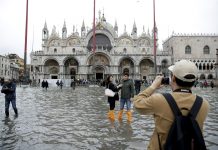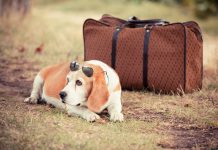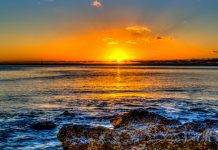
The San Juan Islands and their neighbors in Washington State’s Salish Sea are a place out of time. Shane Mitchell boards the ferry to find the artists, chefs, and urban refugees who live within this archipelago, at a speed of their own choosing.
‘Great day for a boat ride,’ the deckhand tells me, squinting at the cornflower sky as the Elwha prepares to back out of its slip at Anacortes and head into the San Juan Islands. He inspects a van with a kayak on top and a license-plate frame that reads MY OTHER CAR IS A BIKE, then gives the all clear. Passengers stream from their vehicles to the upper deck, some with dogs in tow. In the main cabin, communal jigsaw puzzles await on dining tables. Some folks sit down to hunt for a matching piece, but most head outside to take in the scene and the sunshine. A bird-watcher trains her binoculars on an osprey while a man in a T-shirt that says ONE LESS CAR hangs onto the hoodies of excited twin boys peering over the railing at the ferry’s wake. The receding shoreline is rocky and evergreen. A light breeze ruffles the surface of the Salish Sea, carrying with it the scent of sea lettuce.
The indigenous Coast Salish paddled bidarka canoes through these waters millennia before Greek explorer Ioánnis Phokás, known to his Spanish patrons as Juan de Fuca, sailed into the strait that now bears his name, seeking a sea route linking the Pacific and Atlantic. Today, the primitive watercraft have been replaced by the lumbering giants of the Washington State Ferry System, which regularly service only four of the 172 islands in the San Juan archipelago—part of a greater island network that stretches from Olympia, Washington, to Vancouver, British Columbia.
As the cities of the Pacific Northwest mainland go mainstream, the offshore communities out here remain a counterculture stronghold, more hippie than hipster. The slow pace and cellular dead zones appeal to both nature-loving artists and reclusive tech billionaires, as well as to anyone who prefers to measure speed by knots rather than miles per hour. The San Juans have one of the highest concentrations of bald eagles in the Lower 48. Orcas sing in Haro Strait. Thanks to the rain shadow cast by the Olympic Mountains, the summers are gloriously bright and mild. During the wet winters, the ferry becomes a de facto social hub, filled with joyriders who compete in fierce inter-island mah-jongg tournaments. The constant proximity to water is the defining experience of any journey here. To be any closer would require fins and a tail.
For the ideal trip, start on Whidbey Island, just beyond Seattle’s northern suburbs. Then spend a few nights on San Juan, Orcas, or Lopez, taking day trips to the neighboring islands. Finish on Lummi, where you can order the finest meal the region has to offer.
Whidbey
It’s not technically a part of the San Juans, but this is the place where the tempo of urban life begins to cede to island time. The terminal is on its southeastern flank; on the northern end are the sea bluffs of Deception Pass and the naval air station featured in An Officer and a Gentleman.
Not far from the ferry landing is the Inn at Langley, where chef Matt Costello’s restaurant serves standouts like beet meringue, foraged mushrooms, and troll-caught salmon, and a weirdly good gin and tonic served in a petri dish. The “sweet earth,” however—a scorched-pine pastry cream made with spinach-powder mock moss and brought to the table in a blown-glass terrarium—is his purest celebration of the Pacific Northwest terroir.
On his day off, Costello takes me to Double Bluff State Park at Useless Bay, a few miles from the small farm where he raises ducks and herbs. We hike the tide line, watching kids assemble a driftwood fort. “Beats video games,” Costello quips. The chef, an Olympia native who moved offshore a decade ago, lists other island highlights, including galleries that sell large-scale works by graduates of the nearby Pilchuck Glass School and Toby’s Tavern, a no-frills watering hole frequented by the fishermen who harvest the Penn Cove mussels served in Costello’s restaurant. In the town of Greenbank, we stop at Whidbey Pies Café, where the bakers produce 900 pies a week, for a slice of huckleberry. Langley itself has just two main streets and a single-screen art- house theater. “There is zero anonymity,” Costello says.
San Juan
This island has the largest population in the archipelago, but it’s still under 7,000. The closest thing to a traffic jam here happens when cars line up for the ferry at Friday Harbor, though the opening last year of the San Juan Islands Museum of Art, an airy Modernist cube devoted to the art of the Northwest, should draw more attention to this sleepy town. Upcoming exhibitions will showcase glass maestro William Morris and wildlife photographer Susan Middleton, whose work includes portraits of the elusive giant Pacific octopus, which dwells in these waters.
A drive through bucolic Beaverton Valley leads to Lime Kiln Point State Park, directly across Haro Strait from Vancouver Island. It’s an ideal vantage for spotting orcas, but a guide boat is an even better way to sight the black-and-white whales. Jim Maya, captain of the Peregrine, has an uncanny knack for knowing where a pod will congregate next. His secret weapon is docent Jeanne Hyde, whose enthusiasm for orcas borders on obsession. As the animals “spy hop” to observe us, she identifies her favorites by their dorsal markings. “There’s Blackberry!” she shouts. “And Cousteau!” Maya, a retired schoolteacher, explains that each pod has its own dialect. “Scientists have been trying to figure out the language for years,” he says. “For my own reasons I hope they never do, but I’d give everything to have an hour’s conversation.”
Orcas
Contrary to common assumption, this horseshoe-shaped, 57-square-mile island is not named after the whale. Orcas is a coincidental abbreviation of the name of Horcasitas, the viceroy of Mexico who sent an expedition here in 1791. The main town of Eastsound, a place of white clapboard houses and tidy shops fronted by fragrant Nootka rose bushes, sits in the middle overlooking a deepwater fjord. My first day coincides with the annual Solstice Parade, which highlights Orcas’s Woodstock Nation vibe: musicians bang on homemade drums and puppeteers convey large-scale fantoccini of celestial bodies to a dance circle at the farmers’ market on the Village Green.
Orcas has its own artistic streak. Darvill’s Bookstore (360/376-2135), in Eastsound, hosts author readings and coffee seminars. On a nearby side street, graphic designers Andrew and Emily Youngren have set up their new Printshop Northwest studio. Just outside town, one of Anthony Howe’s astounding kinetic sculptures signposts his studio, which he opens only on a whim and rarely by appointment. “The creativity quotient on this island is crazy,” says Christopher Peacock, a longtime resident and general manger of Rosario Resort & Spa, housed in an Arts and Crafts mansion a few miles south. A trained concert pianist, he performs at cocktail hour on the aeolian pipe organ in the music room. Afterward, in the dining room overlooking Cascade Bay, he mentions that film producer Warren Miller and cartoonist Gary Larson have places on Orcas. But islanders are too laid-back to acknowledge a famous person standing in line for the sticky buns at Brown Bear Baking (360/855-7456).
Peacock also arranges hikes to Mount Constitution in nearby Moran State Park or kayaking trips with naturalist guide Jeff Zbornik. I join Zbornik’s full-day circumnavigation of Sucia Island, part of the state’s marine park system, two miles north across President Channel. The Cascades are visible on the horizon. We paddle through isolated coves where herons perch on sandstone outcroppings and bullwhip kelp waves in the tidal outflow. Zbnornik, who has explored these bays for more than 30 years, calls to the curious porpoise that trails behind us. I dip my hand in to taste the chill seawater. Back on shore at Hogstone’s Wood Oven I order a platter of oysters from nearby Judd Cove and savor the same briny flavor.
Lopez
The low profile of Lopez suits property owners with privacy issues, like Microsoft’s Paul Allen, who inhabits its entire 387-acre Sperry Peninsula. The island’s quiet rural lanes also appeal to bikers, who can pick up reserved rentals near the ferry terminal at a stand operated by Village Cycles, one of the island’s few businesses. Lopez’s gentle topography is ideal for farming; sheep and cattle graze by the roadside, and the many orchards and garden plots supply the San Juans with fresh produce.
In the summer, the six-acre Lopez Island Vineyards hosts Shakespeare performances in its garden. Thanks to a prevailing weather pattern known as the North Pacific Oscillation, Brent Charnley, a bearded winemaker who came here after studying viticulture at the University of California, Davis, is able to grow grapes that are unusual for the Pacific Northwest. His bottles have rarely been seen beyond Seattle, since the locals tend to buy him out, but he’s expanding his production. “We do everything wonky and sideways here,” he explains.
Lummi
My last stop, a nine-square-mile island across Rosario Strait from Orcas, is not officially one of the San Juans, but it’s still considered part of the greater Salish Sea archipelago. It’s reached through the Lummi Nation Reservation, on the mainland north of Bellingham, via a brief crossing on the Whatcom Chief. This time, the license-plate frame of the truck in front of me reads MY OTHER CAR IS A PIRATE SHIP.
A path to the beach at Fern Point is lined with ripe salmonberries. Ravens lurk in the Douglas firs like woodland mobsters. A sea otter scampers around tide pools on Legoe Bay, where Lummi’s reef-net fishermen tend to their boats in advance of sockeye season. It’s too windy to go out on the water, so instead my guide, Kristi Kucera, takes me foraging for edible kelp. We pick our way past granite erratics covered with feathery wakame, collecting stubbly “Turkish towel” and bladder chain washed up on the black sand.
The local artist Ann Morris is also a forager. Her current exhibition, “Crossings,” on view at her studio in a sculpture garden overlooking Rosario Strait, consists of fragile canoe hulls made of found objects—bone, feathers, seaweed, roots—collected on Lummi. Several of her sculptures sit in the garden of the nearby Willows Inn. The century-old Craftsman building has long housed a restaurant, but the arrival in 2011 of Olympia native Blaine Wetzel, a Noma veteran who was named a James Beard Rising Star Chef last year, put it on the dining map. A lean man with burn scars on his forearms, Wetzel walks me around Loganita Farm, the source of most of the organic produce and edible blossoms on his menu. “I want to have fun on my day off,” he says, picking nasturtiums. “Swore I was done with three-star restaurants after eating at one where the waiters actually whispered during dinner service.”
His own dining room is anything but somber. Black-clad waiters wearing aprons circulate with trays of snacks—roasted razor clams, steelhead-roe crêpes—during cocktail hour. The Spotted Owl, with locally distilled Spy Hop gin, Douglas-fir oil, and nettle bitters, is a clever variation on a gin fizz. The slow-roasted lamb en papillote is burly enough for a lumberjack. But it is Wetzel’s Samish Bay mussel, served atop heated beach pebbles in a cedar box that belches woodsmoke when cracked open, that captures the essence of these islands in a single bite.

